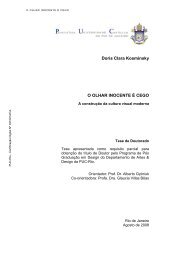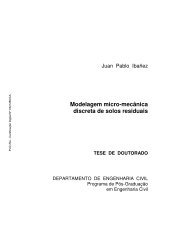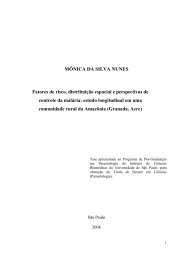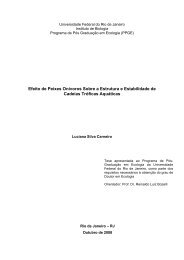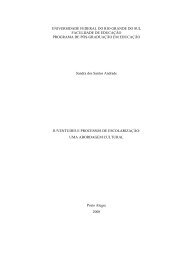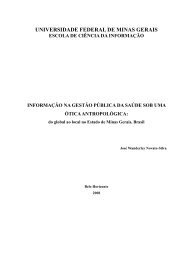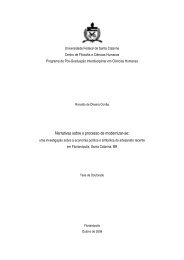Create successful ePaper yourself
Turn your PDF publications into a flip-book with our unique Google optimized e-Paper software.
Molecular Immunology 42 (2005) 1043–1048Hybridization signatures during thymus ontogeny reveals modulationof <strong>gene</strong>s coding for T-cell signaling proteinsDanielle A.R. Magalhães a , Claudia Mace<strong>do</strong> a , Cristina M. Junta a , Stephano S. Mello b ,Márcia M.C. Marques a , Renato S. Car<strong>do</strong>so a , Elza T. Sakamoto-Hojo b ,Eduar<strong>do</strong> A. Donadi c , Geral<strong>do</strong> A.S. Passos a,d,∗a Molecular Immuno<strong>gene</strong>tics Group, Department of Genetics, Faculty of Medicine, University of São Paulo (USP), 14040-900 Ribeirão Preto, SP, Brazilb Laboratory of Cyto<strong>gene</strong>tics and Muta<strong>gene</strong>sis, Department of Genetics, Faculty of Medicine, USP, 14040-900 Ribeirão Preto, SP, Brazilc Department of Medicine, Faculty of Medicine, USP, 14040-900 Ribeirão Preto, SP, Brazild Discipline of Genetics (DMEF), Faculty of Dentistry, USP, 14040-900 Ribeirão Preto, SP, BrazilReceived 18 August 2004; accepted 29 September 2004Available online 23 November 2004AbstractNon-manipulated inbred mouse strains constitutes an interesting model-system for in vivo studies on thymus ontogeny due to the possibilityto observe the molecular events of the thymocyte maturation. In previous studies, using RT-PCR method, we have found that several immunesystem <strong>gene</strong>s such as interleukins and MHC are differentially expressed during ontogeny of the thymus whose <strong>gene</strong>s act as modulators ofT-cell differentiation. To determine which other <strong>gene</strong>s are modulated on a large-scale basis, we measured the levels of mRNA expression inmouse fetal thymus (14–17 days of gestation) by hybridization with cDNA microarrays containing 1,576 cDNA sequences derived from theIMAGE MTB library. T-cell maturation was monitored by detection of the T-cell receptor beta TRBV8.1-BD2.1 rearranged DNA segment.Each developmental phase of thymus, displayed a characteristic expression profile, as evaluated by the Cluster and Tree-View softwares. Genesdifferentially and significantly expressed were selected on the basis of significance analysis of the microarray data (SAM program). With thereclustering of only significantly expressed <strong>gene</strong>s, it was possible to characterize the phases of thymus ontogeny, based on the differentialprofile of expression. Our method provided the detection of <strong>gene</strong>s implicated in the cell signaling, such as the hematopoietic cell signaltransducer <strong>gene</strong>, <strong>gene</strong>s implicated in T-cell calcium influx (tyrosine phosphatase) and calcium signaling proteins (vesicle transport bindingprotein 3, proline rich Gla, casein kinase alpha 1 and Down syndrome homolog protein 1) and a <strong>gene</strong> important for the protein transport,including T-cell receptors chains, towards the cell membrane (Golgi SNAP receptor complex member 2). The results demonstrate that thecDNA microarray used to explore the <strong>gene</strong> expression was useful for understanding the modulation of several cell-signaling <strong>gene</strong>s, includingthe calcium cascade pathway, which is important for individual stages of T-cell maturation and control of anergy during thymus ontogeny.© 2004 Elsevier Ltd. All rights reserved.Keywords: Thymus ontogeny; T-cell signaling; cDNA microarrays; Gene expression profiling; Cluster analysis1. IntroductionThe differentiation of thymocytes to mature T-cells occurswithin the fetal thymus and all developmental stages are distinguishableby their expression of combination of CD cellsurfacemarkers. This is a highly modulated phenomenon,∗ Corresponding author. Tel.: +55 16 602 3030; fax: +55 16 633 0069.E-mail address: passos@rge.fmrp.usp.br (G.A.S. Passos).whose central molecular machinery is formed by the recombinasecomplex (RAG-1 and RAG-2) directly implicated inthe V(D)J recombination of T-cell receptor <strong>gene</strong> segments(TRA, TRB, TRG and TRD) (Lefranc and Lefranc, 2001).The occurrence of the V(D)J reaction is important for triggeringthe maturation of T-cells and is also regulated by severalother <strong>gene</strong> products such as interleukins (Fink and McMahan,2000; Fugmann, 2002; Muegge et al., 1993; Sollof etal., 1997).0161-5890/$ – see front matter © 2004 Elsevier Ltd. All rights reserved.<strong>do</strong>i:10.1016/j.molimm.2004.09.031



